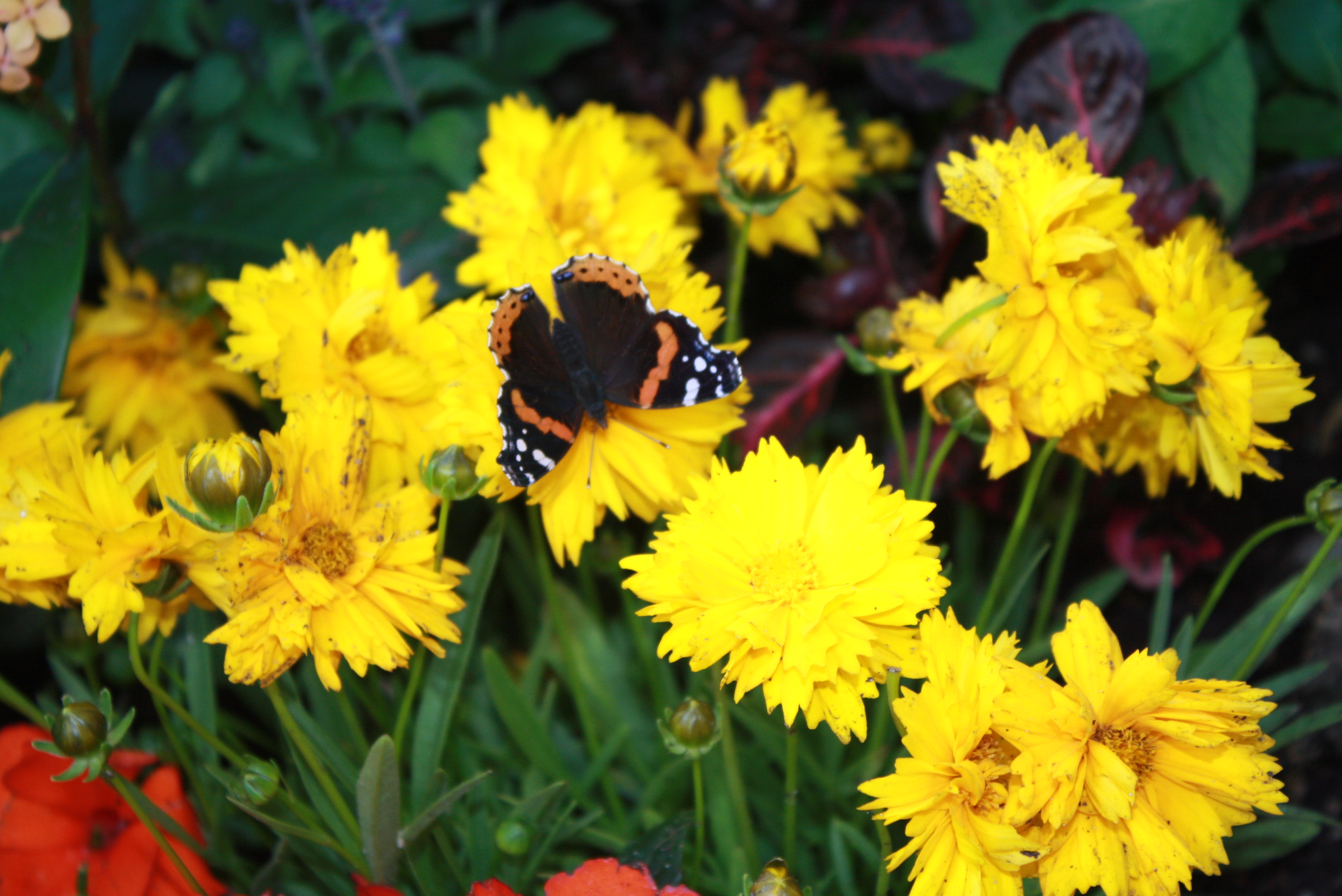
by Matt Lollar | Jun 2, 2017
The Jackson County Master Gardeners are hosting a Mead Making Workshop on Saturday, June 17 at the Jackson County Agricultural Center Classroom, 2741 Penn Avenue, Marianna, FL. Registration opens at 8:30 AM (Central Time) and the event will end at 2:00 PM.
Mead is an alcoholic beverage made from fermenting honey. Mead is described in various writings from Aristotle, Pliny the Elder, and in the epic poem Beowulf. This workshop will teach you everything you need to know in order to make your own mead at home! You will go home with a small carboy, airlock, honey, and yeast.

The registration fee is $35.00 and covers lunch and all materials and equipment to make your own mead. The workshop is limited to 24 participants. For more information, please see the Mead Making Workshop Flyer. You can pay at the door, but we do ask that you call the Jackson County Extension Office to RSVP at: 850-482-9620 or email mlollar@ufl.edu.
by Matt Lollar | May 18, 2017
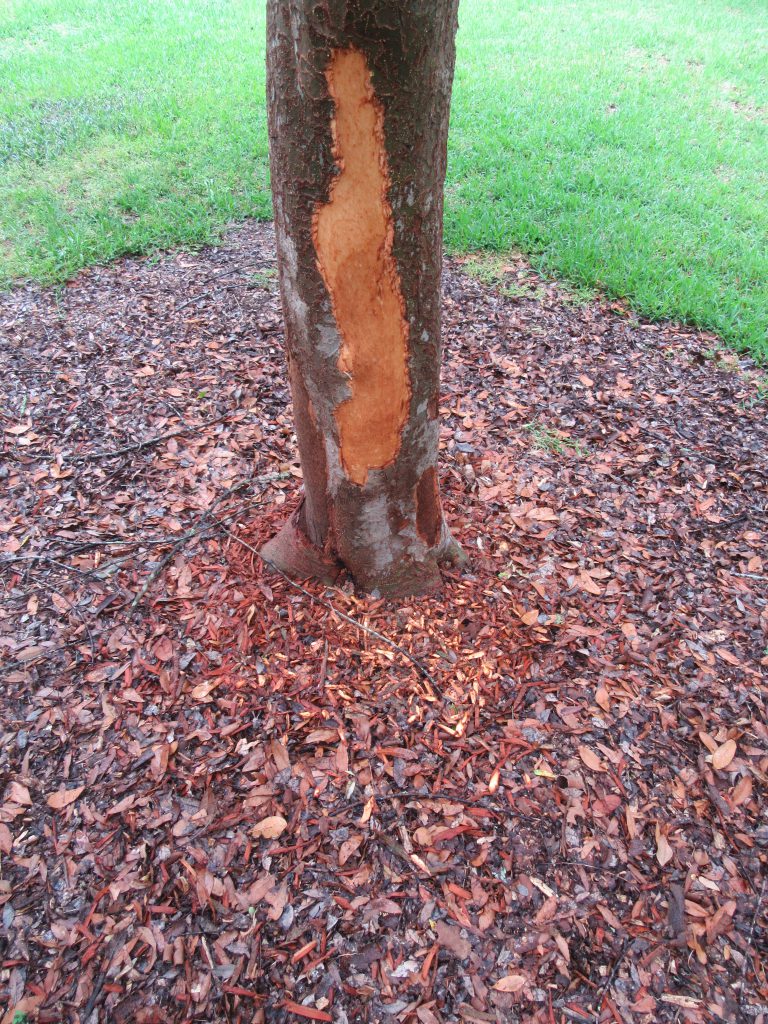
Squirrel bark stripping damage on a Chinese elm. Photo Credit: University of Florida/IFAS Extension
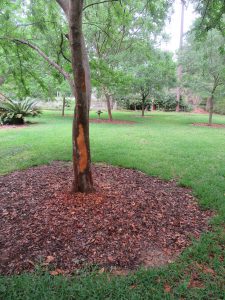
Barked stripped from the trunk of a Chinese elm. Photo Credit: University of Florida/IFAS Extension
The squirrels are at it again! This time they are stripping the bark from the trunks of my Chinese elm (Ulmus parvifolia) trees. Squirrels feed on the bark of a number of other different tree species including oaks, maples, and pecans. There are a few theories as to why squirrels feed on tree bark.
- Pregnant Females – Pregnant squirrels don’t eat prior to giving birth, but it is thought they chew on bark to help them bear the pain of pregnancy.
- Water Source – This theory isn’t very reputable due to the fact that squirrels have been seen feeding on bark come rain or shine.
- Food Source – The inner bark layer (phloem) contains sugar and nutrients which help satisfy a squirrel’s appetite.
The good news is squirrels generally do not eat enough bark to kill a tree. A squirrel will typically only strip a half inch section of bark about three inches long. However, the squirrels in my yard were much hungrier this year as you can see in the featured pictures.
Because squirrels do not usually girdle the trunk of the tree, they generally do not cause enough damage to kill a tree. However, their bark stripping habits can be unsightly in a well-maintained landscape. A few control options are available.
- Tree Wrap – Tree trunks can be wrapped with 24″ or longer aluminum flashing. Unfortunately, this option can be more unsightly than the bark stripped trunks.
- Repellents – A number of different wildlife repellents are on the market. Most repellents do not smell very good because they contain egg solids.
- Harvest – This is my favorite method of control! Make sure you follow all state and local laws.
For more information on wildlife management, please visit EDIS or The Internet Center for Wildlife Damage Management.
by Matt Lollar | Apr 13, 2017
Most of you plant a spring vegetable garden with a number of different vegetable types. However, you may not realize that you are improving the health of your soil and your crops by planting a diverse garden. Intercropping is a gardening practice of growing different crops in the same field. When planting a mixture of crops in the same field year after year, it is important to rotate the location of each type of vegetable. This is a practice known as crop rotation. Intercropping and crop rotation will help reduce insect pest populations, increase beneficial insect populations, and reduce weed populations.
Crop Diversity
Growing plants in your garden that pest insects don’t like to eat makes the pests work harder to find what they do like to eat. Studies have found reduced whitefly numbers on squash plantings mixed with a crop of buckwheat when compared to squash planted alone. Another crop mixture that may be unintentional, but may work in your favor is a row of crapemyrtles along the edge of your garden. Crapemyrtles will attract the crapemyrtle aphid which will attract predatory insects. When the predatory insects run out of crapemyrtle aphids to eat, they will move to your garden and begin to hunt pest insects on your vegetable crop.
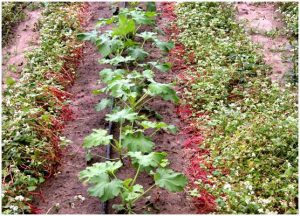
Squash with living mulch of buckwheat. Photo Credit: Oscar Liburd, UF/IFAS Extension
Trap Cropping
A trap crop is a plant that attracts a pest insect away from your food crops. Trap crops work best when planted at the edge of your garden, along a fence row, or in movable containers. A bare space, let’s say 5 feet or so, should be kept between your trap crop and your garden. This will help keep the pests from moving on to your vegetables. When you find a good population of pests on your trap crop then it is time to spray them with insecticide or cut the crop down and remove the debris to a location far from your garden. If your trap crops are planted in containers, then it makes them that much easier to remove from near the garden area.
Cover Crops and Green Manure
Soil organic matter can be increased by the use of green manure and cover crops. Cover crops are generally planted during the off-season, but they can be planted in between vegetable rows and tilled in at a designated time as a green manure. Both cover crops and green manure improve the production of your garden by:
- Suppressing weeds by competing for water, light, and nutrients;
- Holding the soil in place and preventing erosion;
- Scavenging for nutrients that can be utilized in future crops;
- Reducing nematode populations;
- Providing a habitat for beneficial insects.
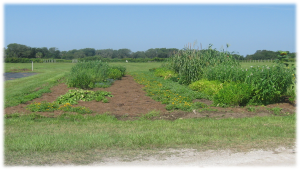
A mixed plot of cover crops and trap crops. Photo Credit: UF/IFAS Extension
A number of different crops can serve as cover crops or green manure crops. Most are legumes (bean family) or grasses. A few that you might like to give a try are:
- Cowpeas
- Sunn hemp
- Sorghum-sudangrass
- Winter rye
More detailed information on cover crops and green manure can be found at this link: http://edis.ifas.ufl.edu/aa217.
by Matt Lollar | Apr 7, 2017

The Jackson County Master Gardeners are hosting “Permaculture: An Introduction” on Saturday, April 29. Join us from 9AM to 2PM on Saturday, April 29 at the Jackson County Extension Office (2741 Penn Ave., Ste.#3, Marianna, FL) to learn the basics of permaculture. What is permaculture you might ask? Basically, it is the utilization of edible plants in your landscape to create a food forest. The workshop is $20 and includes lunch. To register or for more details please contact Matt Lollar at mlollar@ufl.edu, (850)482-9620, or come by the Jackson County Extension Office.

by Matt Lollar | Mar 20, 2017

A type III fairy ring. Photo Credit: Alex Bolques, Assistant Professor, Florida A&M University
Mushrooms often are grouped in a circle in your lawn. This is due to the circular release of spores from a central mushroom. “Fairy Ring” is a term used to describe this phenomenon. Fairy rings can be caused by multiple mushroom species such as Chlorophyllum spp., Marasmius spp., Lepiota spp., Lycoperdon spp., and other basidiomycete fungi.
Occurrence
Fairy rings most commonly invade your yard during the summer months, when the Florida panhandle receives the most rain. The mushrooms cause the development and spread of the rings by the release of spores. Spores produce more mushrooms and are similar to the seed produced by plants.
Fairy Ring “Types”
Fairy rings can be seen in three forms:
- Type I rings have a zone of dead grass just inside a zone of dark green grass. Weeds often invade the dead zone.
- Type II rings have only a band of dark green turf, with or without mushrooms present in the band.
- Type III rings do not exhibit a dead zone or a dark green zone, but a ring of mushrooms is present.
The size and fill of rings varies considerably. Rings are often 6 ft or more in diameter. The fill of a ring can range from a quarter circle to a semicircle or full circle.
Cultural Controls
The rings will disappear naturally, but it could take up to five years. Although it is possible to dig up the fairy ring sites, it is a good possibility the rings will return if the food source (buried, rotting wood or other organic matter) for the fungi is still present underground.
In some situations, the fungi coat the soil particles and make the soil hydrophobic (meaning it repels water), which will result in rings of dead grass. If the soil under this dead grass is dry but the soil under healthy grass next to it is wet, then it is necessary to aerate or break up the soil under the dead grass with a pitchfork or other cultivation tool.
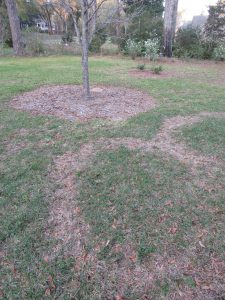
Rings of dead turf due to fairy ring fungi. Photo Credit: University of Florida/IFAS Extension.
Chemical Controls
Effective fungicides include products containing the active ingredients azoxystrobin, flutolanil, metconazole, pyraclostrobin, and triticonazole.
Fungicides inhibit the fungus only. They do not eliminate the dark green or dead rings of turfgrass and do not solve the dry soil problem.
A homeowner’s guide to lawn fungicides can be found at the University of Florida/IFAS Extension Electronic Data Information Source (EDIS) website (http://edis.ifas.ufl.edu/document_pp154).










